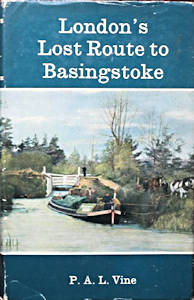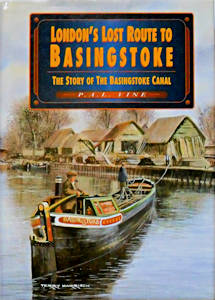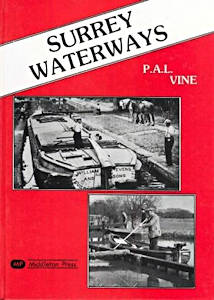Basingstoke Canal

Seal of the original Basingstoke Canal Company

Map of the Basingstoke Canal
The Basingstoke Canal was authorised by an Act of Parliament in 1778 to make a canal from the Wey Navigation at Woodham near Byfleet in Surrey to Basingstoke via Woking, Frimley and Odiham with branch to Turgis Green. The American War of Independence and subsequent war with France prevented capital being raised. It was only in 1787 that a prospectus of traffic and revenue was issued. At the same time the idea of a branch to Turgis Green was abandoned in favour of a tunnel at Greywell. The canal was opened in 1794.

Lock 10 at St Johns, Woking, before restoration.
© Peter Oates 2022. Image scanned from slide.
Joseph Priestley in his book “Priestley’s Navigable Rivers and Canals” published in 1831 gives a short account of the canal. This has been extracted and may be seen (as a PDF file) here.
The company never succeeded in developing enough traffic to pay off all the interest on its borrowings, let alone pay a dividend. A major cause of the canal’s lack of commercial success was the failure to extend the waterway beyond Basingstoke in spite of many attempts. For over thirty years proposals were made for linking the waterway with various towns, the English Channel and the Kennet & Avon Canal.
The opening of the London & Southampton Railway in 1839 reduced canal receipts by about 50%. In 1866 the canal company went into voluntary liquidation. Over the next 50 years the canal fell into the hands of a succession of speculators, few more successful than the last. Local developments kept the canal in use. The construction of the London & Southampton Railway in the 1830s, followed by Aldershot Camp in 1854 and the short-lived brickworks at Up Nateley in the 1890s for which the canal was restored and deepened, all brought periodic trade.

Lock 10 at St Johns, Woking, after restoration.
© Peter Oates 2022. Image scanned from slide.
The purchase of the canal by A J Harmsworth in 1923 brought a revival in trade to Woking. But when the gas company ceased to manufacture its own gas in 1936, a substantial proportion of the canal’s remaining trade ceased. Commercial traffic ended in 1949 and the canal became increasingly derelict with unworkable locks and the channel a marshy swamp.
The formation of the Surrey & Hampshire Canal Society (later renamed the Basingstoke Canal Society) in 1966 brought about restoration of the canal. The Society persuaded both Hampshire and Surrey County Councils to compulsorily purchase the canal in 1973 and 1976 so that restoration could proceed. Voluntary working parties and school leavers, some employed by the Manpower Services Commission, worked to clear the undergrowth, rebuild the locks and dredge the channel. 32 miles of the canal were finally opened in 1991 from Woodham to nearly half a mile (700m) from Greywell Tunnel to much public acclaim, having taken 18 years to complete. Today, the canal is administered by the Basingstoke Canal Authority - a joint body set up by the two County Councils. However its usage is currently still limited by low water supply and conservation issues.
Further information about the canal can be found on the following websites:
| Website | Link |
|---|---|
| Basingstoke Canal Society | https://basingstoke-canal.org.uk/ |
| Basingstoke Canal Authority | https://www.hants.gov.uk/thingstodo/basingstokecanal/ |
| Wikipedia | https://en.wikipedia.org/wiki/Basingstoke_Canal |
Further information about the canal can also be found in the following books. Note: all these books are currently out of print but may be found secondhand via the internet, bookshops or even your local library. Click on the book image to see larger version(s). In addition to the books listed below, a number of books and booklets are available through the Basingstoke Canal Society’s website.
The Canals of South and South East England
×
Hardback
London’s Lost Route to Basingstoke
×
1st Edition

2nd Edition
Hampshire Waterways
×
Hardback
Surrey Waterways
×
Hardback
Further research
If you wish to delve even deeper into the canal’s past, there is a page on this website which provides information about various resources that might help you to find out more than the above books and documents provide.
Details of various resources, local and national, can be found here.